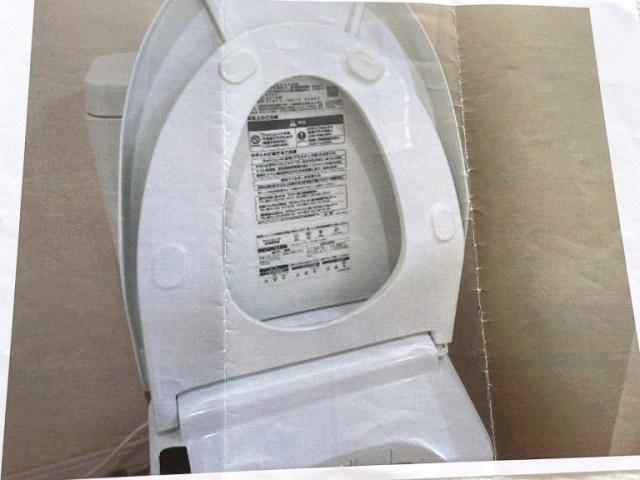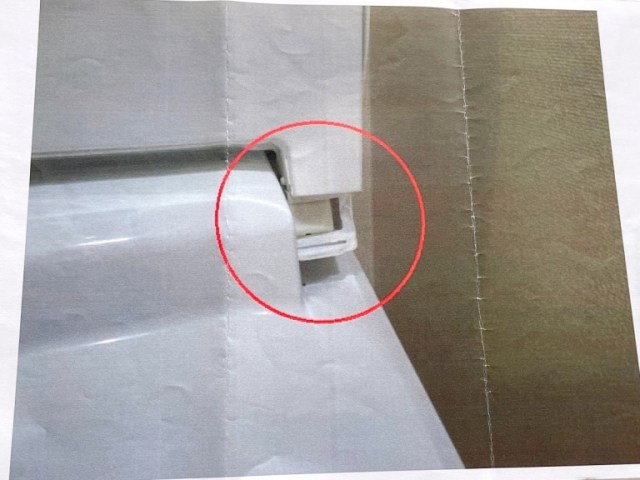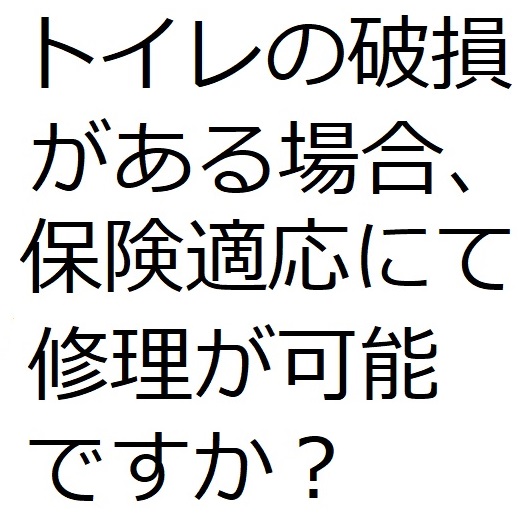
Got a busted toilet in your place in Japan? Check for this before you pay the whole repair bill.
When moving into a new apartment in Japan, there are a lot of different payments you have to make. There’s the first and last month’s rent, security deposit, real estate agency fee, the one-time move-in fee paid to the landlord called “key money,” and the fee for actually changing the locks and making new keys. So by the time you get to the part of the process where you’re required to pay for “fire disaster insurance,” you’ll probably just shrug your shoulders and say “Yeah, that makes sense” without reading all of the fine print.
But here’s the thing about “fire disaster insurance”: it doesn’t just cover you against fire damage, and sometimes it also works as toilet insurance.
First, let’s take a quick look at the linguistics for this required insurance for renters. In Japanese it’s called kasai hoken, which is written in kanji like this.
This does literally translate as “fire disaster insurance.” The first kanji, 火, means “fire,” and the second 災, is “disaster.” Together they become 火災, kasai, meaning a destructive fire (as opposed to, say, a cooking fire or campfire). And 保険/hoken is the Japanese word for “insurance.”
But even though the name only mentions fire, kasai hoken is really an umbrella policy that covers all sorts of unpleasant situations. In addition to fire, it also usually functions as insurance against flood, wind, snow, hail, and water damage, and sometimes even certain instances of damage as a result of flying object impact and theft. And as we mentioned above, your “fire disaster insurance” may also cover damage to bathroom fixtures like your bathtub, washbasin, and toilet.
We found this out recently when one of our Japanese-language reporters, Ahiruneko, was moving out of his old apartment, which got him thinking about his recently broken toilet seat.
Since the bowl itself is OK, Ahiruneko had just kept on using the toilet without getting the seat fixed. As part of the process of moving out, though, the landlord would be doing a final check of the apartment, and Ahiruneko figured the cost of the toilet repairs was going to come out of his deposit. What’s worse, since it’s a fancy washlet-style toilet, he figured it wasn’t going to be cheap to fix.
So he asked his landlord whether repair costs for the toilet might be covered under his kasai hoken policy. The landlord told him he’d have to check with the insurance provider, so that was the next call Ahiruneko made, and to his happy surprise, they told him that yep, his “fire disaster insurance” also works as toilet insurance.
The section of Ahiruneko’s insurance contract that the arrow is pointing to in the above photo indicates that repair costs of up to one million yen (US$6,850) for his apartment’s toilet, washbasin, or bathtub are covered, with Ahiruneko having to pay just 10,000 yen out of his own pocket. This turned out to be great news, because when the landlord came by for his pre-move-out inspection, they assessed that it was going to cost 28,000 yen to repair the toilet.
So in the end, Ahiruneko’s “fire disaster insurance” ended up saving him 18,000 yen in toilet repairs, more than half the total bill.
We should note that the exact details of kasai hoken coverage may vary by insurance provider. If you want to check if yours will cover toilet repairs, you can ask the customer service rep “Toire no hason ga aru baai, hoken tekiou nite shuuri ga kanou desu ka?”, which means “In the case of damage to the toilet, can my insurance be applied to the repairs?”
▼ That same phrase, written in Japanese
If you want to change that to asking about the bathtub, all you have to do is swap out toire (トイレ) and put in yokusou (浴槽), and if you’re asking about the washbasin, the word to use is senmendai (洗面台).
If the fixture that needs fixing is covered by your insurance, the exact process for filing the claim also may vary by provider, but in general you’ll need a document confirming the repair cost from your landlord, which will then need to be supplied to your insurance provider. In Ahiruneko’s case, he ended up having the full repair cost of 28,000 yen deducted from his security deposit, and after that he received a notice from his insurance provider saying that they had approved his claim and sent the money to his landlord, who then transferred the money into his bank account. With all that sorted out, though, he’s got 18,000 extra yen in his pocket, and he’s thankful that his “fire disaster insurance” kept him from getting burned for the full repair bill.
Reference: General Insurance Association of Japan
Images ©SoraNews24
● Want to hear about SoraNews24’s latest articles as soon as they’re published? Follow us on Facebook and Twitter!
[ Read in Japanese ]






 Japanese company offers insurance plan to protect against false train groping accusations
Japanese company offers insurance plan to protect against false train groping accusations “Bully insurance” now on the rise, with many more practical uses than just insuring bullying
“Bully insurance” now on the rise, with many more practical uses than just insuring bullying Tokyo realtor will give you hundreds of dollars of anime decorations for your new apartment
Tokyo realtor will give you hundreds of dollars of anime decorations for your new apartment Nintendo’s god-tier customer service continues as they offer free repairs for Noto earthquake victims
Nintendo’s god-tier customer service continues as they offer free repairs for Noto earthquake victims What to do if you want to lower your apartment rent or avoid paying key money in Japan
What to do if you want to lower your apartment rent or avoid paying key money in Japan Seaside scenery, history, and so many desserts on Yokohama’s Akai Kutsu【Japan Loop Buses】
Seaside scenery, history, and so many desserts on Yokohama’s Akai Kutsu【Japan Loop Buses】 Foreigner’s request for help in Tokyo makes us sad for the state of society
Foreigner’s request for help in Tokyo makes us sad for the state of society Japanese city loses residents’ personal data, which was on paper being transported on a windy day
Japanese city loses residents’ personal data, which was on paper being transported on a windy day Ghibli Park now selling “Grilled Frogs” from food cart in Valley of Witches
Ghibli Park now selling “Grilled Frogs” from food cart in Valley of Witches Princesses, fruits, and blacksmiths: Study reveals the 30 most unusual family names in Japan
Princesses, fruits, and blacksmiths: Study reveals the 30 most unusual family names in Japan Historical figures get manga makeovers from artists of Spy x Family, My Hero Academia and more
Historical figures get manga makeovers from artists of Spy x Family, My Hero Academia and more Celebrate another year of life by putting it in jeopardy with this birthday candle flower
Celebrate another year of life by putting it in jeopardy with this birthday candle flower Should you add tartar sauce to Japanese curry rice? CoCo Ichi makes diners an unusual offer
Should you add tartar sauce to Japanese curry rice? CoCo Ichi makes diners an unusual offer Japanese woman stumbles on the power of the infamous “gaijin seat” phenomenon during flight
Japanese woman stumbles on the power of the infamous “gaijin seat” phenomenon during flight French Fries Bread in Tokyo’s Shibuya becomes a hit on social media
French Fries Bread in Tokyo’s Shibuya becomes a hit on social media McDonald’s new Happy Meals offer up cute and practical Sanrio lifestyle goods
McDonald’s new Happy Meals offer up cute and practical Sanrio lifestyle goods Japanese ramen restaurants under pressure from new yen banknotes
Japanese ramen restaurants under pressure from new yen banknotes Studio Ghibli releases new action figures featuring Nausicaä of the Valley of the Wind characters
Studio Ghibli releases new action figures featuring Nausicaä of the Valley of the Wind characters Red light district sushi restaurant in Tokyo shows us just how wrong we were about it
Red light district sushi restaurant in Tokyo shows us just how wrong we were about it New private rooms on Tokaido Shinkansen change the way we travel from Tokyo to Kyoto
New private rooms on Tokaido Shinkansen change the way we travel from Tokyo to Kyoto Tokyo Tsukiji fish market site to be redeveloped with 50,000-seat stadium, hotel, shopping center
Tokyo Tsukiji fish market site to be redeveloped with 50,000-seat stadium, hotel, shopping center Beautiful Ghibli sealing wax kits let you create accessories and elegant letter decorations【Pics】
Beautiful Ghibli sealing wax kits let you create accessories and elegant letter decorations【Pics】 Studio Ghibli releases Kiki’s Delivery Service chocolate cake pouches in Japan
Studio Ghibli releases Kiki’s Delivery Service chocolate cake pouches in Japan New definition of “Japanese whiskey” goes into effect to prevent fakes from fooling overseas buyers
New definition of “Japanese whiskey” goes into effect to prevent fakes from fooling overseas buyers Our Japanese reporter visits Costco in the U.S., finds super American and very Japanese things
Our Japanese reporter visits Costco in the U.S., finds super American and very Japanese things All-you-can-drink Starbucks and amazing views part of Tokyo’s new 170 meter-high sky lounge
All-you-can-drink Starbucks and amazing views part of Tokyo’s new 170 meter-high sky lounge More foreign tourists than ever before in history visited Japan last month
More foreign tourists than ever before in history visited Japan last month New Pokémon cakes let you eat your way through Pikachu and all the Eevee evolutions
New Pokémon cakes let you eat your way through Pikachu and all the Eevee evolutions Disney princesses get official manga makeovers for Manga Princess Cafe opening in Tokyo
Disney princesses get official manga makeovers for Manga Princess Cafe opening in Tokyo Sales of Japan’s most convenient train ticket/shopping payment cards suspended indefinitely
Sales of Japan’s most convenient train ticket/shopping payment cards suspended indefinitely Sold-out Studio Ghibli desktop humidifiers are back so Totoro can help you through the dry season
Sold-out Studio Ghibli desktop humidifiers are back so Totoro can help you through the dry season Japanese government to make first change to romanization spelling rules since the 1950s
Japanese government to make first change to romanization spelling rules since the 1950s Ghibli founders Toshio Suzuki and Hayao Miyazaki contribute to Japanese whisky Totoro label design
Ghibli founders Toshio Suzuki and Hayao Miyazaki contribute to Japanese whisky Totoro label design Doraemon found buried at sea as scene from 1993 anime becomes real life【Photos】
Doraemon found buried at sea as scene from 1993 anime becomes real life【Photos】 Tokyo’s most famous Starbucks is closed
Tokyo’s most famous Starbucks is closed One Piece characters’ nationalities revealed, but fans have mixed opinions
One Piece characters’ nationalities revealed, but fans have mixed opinions We asked a Uniqlo employee what four things we should buy and their suggestions didn’t disappoint
We asked a Uniqlo employee what four things we should buy and their suggestions didn’t disappoint Crazy cheap hotel in Tokyo comes with a crazy catch【Photos】
Crazy cheap hotel in Tokyo comes with a crazy catch【Photos】 Tokyo schoolgirls invent eco and cost-friendly portable toilet for disaster relief【Video】
Tokyo schoolgirls invent eco and cost-friendly portable toilet for disaster relief【Video】 7-Eleven’s new Ebiten tempura shrimp rice ball is premium in both taste AND cost
7-Eleven’s new Ebiten tempura shrimp rice ball is premium in both taste AND cost Are you game enough to eat Fire Ramen at this Japanese restaurant in Kyoto?
Are you game enough to eat Fire Ramen at this Japanese restaurant in Kyoto? Kyoto’s awesome fire ramen: A one-of-a-kind dining experience our reporter Mai just tried【Video】
Kyoto’s awesome fire ramen: A one-of-a-kind dining experience our reporter Mai just tried【Video】 Bulky boxes of wagyu beef can be yours with Japan’s rental frying pan/meat subscription service
Bulky boxes of wagyu beef can be yours with Japan’s rental frying pan/meat subscription service From bad to worse: Japanese driver hits car, sends it flying into Ferrari/Lamborghini showroom
From bad to worse: Japanese driver hits car, sends it flying into Ferrari/Lamborghini showroom Sompo Japan offers nation’s first online flaming insurance
Sompo Japan offers nation’s first online flaming insurance You can now buy bully insurance for your kids in Japan
You can now buy bully insurance for your kids in Japan Saizeriya’s private solo booths are one of the best places to work, drink and eat in Japan
Saizeriya’s private solo booths are one of the best places to work, drink and eat in Japan All-you-can drink deal in Japan puts the self-serve drinks machine right on your table
All-you-can drink deal in Japan puts the self-serve drinks machine right on your table Squat toilets’ popularity fading as parents call for them to be abolished in Japanese schools
Squat toilets’ popularity fading as parents call for them to be abolished in Japanese schools Taste test battle! The new Mister Donut ice cream bar vs. a frozen Mister Donut donut【Taste test】
Taste test battle! The new Mister Donut ice cream bar vs. a frozen Mister Donut donut【Taste test】 Is Coca-Cola Japan’s new canned Jack Daniels cocktail better than mixing your own?【Taste test】
Is Coca-Cola Japan’s new canned Jack Daniels cocktail better than mixing your own?【Taste test】 We investigate the half-priced beer at Sushiro that everyone is angry about
We investigate the half-priced beer at Sushiro that everyone is angry about Everything you think you know about your washlet toilet is wrong
Everything you think you know about your washlet toilet is wrong How much money do you need to live in your own apartment in Japan?【Survey】
How much money do you need to live in your own apartment in Japan?【Survey】
Leave a Reply